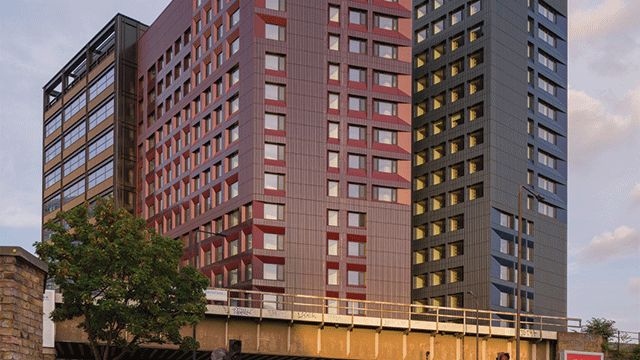Developers and funders in the UK’s build-to-rent sector are increasingly looking across the Atlantic for inspiration – and caution. Law firm Womble Bond Dickinson surveyed 700 UK BTR developers and investors, of which 75% believe the more mature US rental market offers valuable insights for the UK as it scales up delivery and seeks to stabilise returns in a challenging macroeconomic environment.
As a transatlantic law firm, Womble Bond Dickinson compared the two models. While the US BTR sector is largely defined by single-family rental communities and multi-family housing under institutional ownership, the UK market features a broader typology – from suburban homes to vertical apartment schemes – but is now grappling with many of the same pressures: planning delays, affordability concerns and the long-term viability of large-scale rental as a core asset class.
“US BTR is largely focused on single-family communities, driven by suburban demand and established financial models,” said Kenneth Van Winkle, vice chair of Womble Bond Dickinson in the US. “Although the UK market takes a different path, there are intriguing similarities.”
US multi-family housing has long been a pillar of urban growth and is deeply institutionalised – an attractive precedent for UK investors seeking scale, resilience and liquidity. With 83% of UK respondents reporting familiarity with the US institutional model, WBD’s report suggests the UK could adapt key features, particularly in financing and planning certainty.
Capital, liquidity and a cautionary tale
A differentiator is land use. The US zoning system, managed at city and municipal level, offers developers predictable pathways through planning – something conspicuously absent in the UK. By contrast, the UK’s politicised and committee-led planning process is cited by WBD respondents as one of the most significant inhibitors of delivery.
“A zoning-like model could provide UK developers with more clarity, involving communities earlier and avoiding prolonged disputes,” said Tom Willows, partner at WBD. “We’ve seen how the US model mitigates NIMBYism and accelerates housing delivery.”
This is increasingly relevant, as BTR operators encounter public resistance to institutional ownership of large housing stock, a debate already maturing in the US.
The financial structuring of the US housing market, particularly via government-sponsored entities, enables capital recycling at scale. Mortgages are securitised, creating a strong secondary market that attracts banks and institutional investors, facilitating liquidity and long-term project viability.
Some 41% of UK respondents believe this model could inform better financing solutions for UK BTR schemes, especially around standardisation, project management and risk distribution. But there is a cautionary edge to this. In the US, institutional purchasing has contributed to pricing out would-be homeowners, prompting proposals for legislation to cap ownership levels and impose rent controls.
“More and more Americans who want to purchase their own home are being priced out,” added Van Winkle. “The UK hasn’t reached that point but it’s a signal of what may lie ahead.”
Policy support also differs markedly. In the US, federal programmes such as Low-Income Housing Tax Credits and the backing of Fannie Mae and Freddie Mac have long underpinned institutional confidence. The UK, by contrast, lacks an equivalent safety net, with policy interventions often reactive or inconsistent. According to WBD, 72% of UK respondents say clearer government backing – especially around land release and funding guarantees – would catalyse faster BTR delivery.
Willows said: “The UK BTR sector must be crystal clear about additionality, communicating that institutional capital enables the delivery of more homes faster, not fewer. Without that narrative, we risk facing the same moral and political challenges seen in the US.”
Scale and scrutiny
Despite those warnings, the fundamentals in the UK remain bullish. The WBD report tracked £800m of investment in Q1 and over 127,000 completed homes nationally.
Institutional appetite remains high, with 50% of funders reporting a very strong interest in the sector. More than 65% of respondents believe BTR has a major role to play in solving the UK housing crisis.
Sustainability is another driver. Some 98% of developers now cite ESG criteria as central to funding strategies. Yet high capital costs and regulatory friction remain barriers. Nearly 40% flagged material and design costs as deterrents to low-carbon construction, while 34% raised concerns over planning uncertainty.
“The BTR opportunity is highly significant—but delays linked to the Building Safety Act and net zero policy uncertainty are eroding delivery confidence,” said John Connor, head of financial institutions at WBD.
Developers increasingly recognise that financial performance is tied to placemaking. Ninety-five percent of respondents agreed that integrating schools, healthcare and green space into BTR schemes enhances long-term value and builds trust. Half of funders surveyed now apply stricter ESG screens to new opportunities, indicating a maturing alignment between capital and community outcomes.
“Sustainability and profitability are no longer opposites,” said Bela Zavery, partner at WBD. “They are converging priorities for investors, local authorities and tenants alike.
As the UK BTR sector enters a phase of scale and scrutiny, its ability to learn from the successes and pitfalls of the US model may define its trajectory. Institutional capital, smart regulation and localised planning are crucial enablers, but so too is narrative discipline. Without a clear social licence, UK BTR risks repeating the affordability tensions now surfacing in the US. “There are powerful lessons from across the Atlantic,” said Willows. “But perhaps the most important is this: the success of BTR doesn’t just rely on capital – it depends on consensus.”
Image: © Adobe Stock
Send feedback to Akanksha Soni
Follow Estates Gazette











